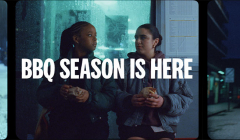
KFC prepares for British BBQ weather
The summer campaign for KFC’s Ultimate BBQ Burger readies Britain for rainy BBQs

Brands must consider a broad range of influencer talent to get ahead and collaborate in more innovative ways

"Stealing yo man since 1928" – so reads the Instagram tagline of 95-year-old social media influencer (and icon) Baddiewinkle. With more than three million followers, she is known for her wicked sense of humour and ability to positively impact the fight against ageism through her captivating, attention-grabbing content. At the other end of the spectrum is Ryan’s World, the 12-year-old influencer who, despite his young age, was the highest-paid YouTuber between 2018-2020 and has over 36 million subscribers. Both Baddiewinkle and Ryan’s World are classed as influencers, content creators and social media geniuses – yet they are different in every way.
For those who pay close attention, new windows of opportunity can be spotted in creator marketing. Gradually brands have learned about the power of different demographics; be that the importance of the role of the creator in general, identifying different subcultures to be immersed in, or unique niches to explore. Harnessing the power of creators across different generations has untapped potential. So the big question is, how can brands get ahead and collaborate with them in different ways?
Harnessing the power of creators across different generations has untapped potential.
Jamie Ray, Co-Founder at Buttermilk
This demographic represents the youngest generation of influencer, or ‘kidfluencer’, and typically range from newborns to around 13 years old. Gen Alpha is set to be the largest demographic in history, with more than two billion people expected to fall into this category. Kidfluencers’ content is there to educate others of the same age, whether about the latest games or even skincare routines.
It’s a family affair when it comes to Gen Alpha, as this group is only just reaching the age where they can have their own social media profiles. Because of their age, brands need to ensure heightened responsibilities and put policies in place to safeguard the young creators they work with to protect this group online. An effective approach to consider is partnerships between kidfluencers and their families, involving them in every step.
Not only does Gen Z have a keen eye for what’s new and trending, but they’re also the ones setting these trends and driving cultural shifts. Being trend-led means that their interests can change rapidly – think Mobwife, Tube Girl or Rat Girl – all trends which had their moment, but are now old news.
Brands working with Gen Z need to be agile and understand that in the blink of an eye, trends will move on. Remember, Gen Z is always several steps ahead – they know exactly what is trending and what will drive engagement for a campaign. Putting trust in this generation of creators and giving them the freedom to jump on the most recent craze is what will give brands a competitive edge.
This generation values authentic and relatable content. Often wary of traditional advertising that can appear as insincere, Millennials place more trust in recommendations from their friends and family, or influencers they deem genuine.
Millennials also highly value when a brand really listens to their thoughts, opinions and implements feedback. Brands should consider millennials as a powerful demographic to co-create with their community – ask them to get involved, share their thoughts and expertise; be that product development or getting advice on communicating with their community.
Compared with other generations, Gen X has more niche interests, rather than engaging with broader trends. Influencers from this group often focus on specific expertise or hobbies, and their content has a practical, down-to-earth approach. While they might not chase the latest trends, they instead offer valuable insights and recommendations within their niche areas.
Brands need to know their stuff when it comes to partnering with Gen X, ensuring there’s a clear alignment between the brand and creator. If a brand doesn’t fit within a creator’s specific niche or interest, it won’t be relevant to their audience and followers will simply ignore the message. It all comes down to the perfect match; by working with influencers who embody the spirit of a brand, and whose interests match what the brand stands for, audiences will be much more likely to engage with a campaign, and in turn – the brand.
Baby Boomers are quickly becoming one of the most exciting groups on social media as they are challenging stereotypes around ageing. This generation wants to work with brands that empower them to embrace their age, rather than falling into the same, tired preconceptions.
Brands are beginning to recognise the importance of targeting Baby Boomers, not just for their purchasing potential but also for their influence on younger generations and their ability to reshape societal perceptions of ageing. This generation is rewriting the rulebook, and brands should be listening.
When working with different generations of influencers, adaptability is key – brands must recognise that each age range has its own unique, powerful style and if tapped correctly, the value is unmatched. This diversity not only enhances brand visibility and credibility but also creates opportunities for expansion into new markets. Understanding and harnessing creators’ qualities across generations is essential for brands aiming to connect with diverse audiences, tailor strategies and stay ahead in culture.
Jamie Ray is the co-founder of Buttermilk, an award-winning global influencer marketing agency. Doubling in size year on year & with multiple international offices, Jamie has led Buttermilk to the top of the influencer marketing sector.
Looks like you need to create a Creativebrief account to perform this action.
Create account Sign inLooks like you need to create a Creativebrief account to perform this action.
Create account Sign in